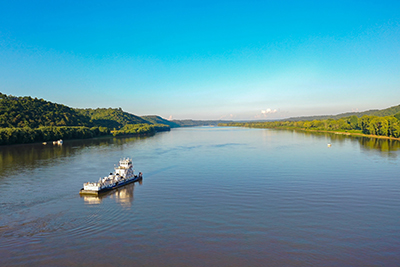Client: Electric Power Research Institute (link opens in a new tab)
Location: Ohio River | West Virginia, Ohio, Kentucky, Indiana, and Illinois
 Since 1970, various utility companies sponsored aquatic biological studies on the Ohio River as part of the Ohio River Ecological Research Program (ORERP). These companies have included American Electric Power Company, American Municipal Power-Ohio, Buckeye Power, The Dayton Power & Light Company-AES Corporation, Duke Energy, FirstEnergy Services Company, LG&E and KU Energy-PPL Companies, Ohio Valley Electric Corporation/Indiana-Kentucky Electric Corporation, Owensboro Municipal Utilities, Tennessee Valley Authority, and Vectren Corporation. The primary program objective was the development of a quantitative and qualitative database for the evaluation of power plant impacts on fish and fish communities and associated environmental regulatory matters. The Ohio River Ecological Research Program (ORERP): History and Accomplishments was a Feature Article in Fisheries.
Since 1970, various utility companies sponsored aquatic biological studies on the Ohio River as part of the Ohio River Ecological Research Program (ORERP). These companies have included American Electric Power Company, American Municipal Power-Ohio, Buckeye Power, The Dayton Power & Light Company-AES Corporation, Duke Energy, FirstEnergy Services Company, LG&E and KU Energy-PPL Companies, Ohio Valley Electric Corporation/Indiana-Kentucky Electric Corporation, Owensboro Municipal Utilities, Tennessee Valley Authority, and Vectren Corporation. The primary program objective was the development of a quantitative and qualitative database for the evaluation of power plant impacts on fish and fish communities and associated environmental regulatory matters. The Ohio River Ecological Research Program (ORERP): History and Accomplishments was a Feature Article in Fisheries.
EA conducted this program in 1991, 1992, and annually from 2000-2019 at up to 22 power plants that nearly spanned the entire length of the Ohio River. The ORERP was an Electric Power Research Institute Supplemental Research Project from 2002-2019. EA conducted a variety of studies for ORERP that included:
Annual Fisheries Monitoring Program
The annual fisheries monitoring program consisted of adult/juvenile fish, habitat, and water quality field studies. Surveys were conducted seasonally (typically in June, August, and October) at three electrofishing and seining locations upstream and downstream of each plant. Electrofishing was conducted at night and seining during the day. The principal research objectives were to evaluate possible effects of thermal effluents on the temporal and spatial distributions of juvenile and adult fish in the Ohio River and investigate any associations with hydrological, water quality, and habitat characteristics. Habitat at each seining location was evaluated using Ohio EPA’s Qualitative Habitat Evaluation Index, whereas habitat at each electrofishing location was evaluated using a method developed by the Ohio River Valley Water Sanitation Commission. For both gears, data were evaluated using abundance, biomass, species richness, and catch rate data. Electrofishing data are also evaluated using the Modified Index of Well-Being (MIwb), the modified Ohio River Fish Index (mORFIn), and Shannon diversity indices. Because the sponsorship of the program changed from year to year, the number of plants studied also varied annually. The largest participation (6-17 plants per year) occurred from 2004 through 2018 with three to five plants studied in all other years. During the expanded studies from 2004 through 2018, EA has collected over a million fish representing 135 fish species.
Special Winter Fisheries Program
During 2007, 2008, and 2009, EA conducted an unprecedented winter monitoring program at eight power plants. This program consisted of night electrofishing (all years) and seining (2007 and 2008). The study area spanned nearly 700 river miles. The objective of this program was to determine the extent to which fish were attracted to the thermal discharges. The winter electrofishing survey results demonstrated that attraction was most evident in the sampling zone nearest a plant’s discharge when water temperatures averaged about 5.9°C higher than the ambient (upstream) temperatures. Although all of the winter electrofishing community-level parameters were numerically higher downstream at six of the eight plants, they were usually statistically similar to the upstream results. Catches during the winter surveys were much lower and included fewer species than were collected during the June–October seasonal surveys. These lower catches were primarily the result of the absence of young-of-year (or age-1) fishes but also likely reflect a combination of the effects of cold water temperatures on gear efficiency, the distribution of fishes in the river, lower water clarity, and higher flows than were encountered during the standard seasonal surveys.
Clean Water Act §316(B) Support
From 2014 through 2020, EA provided a variety of support in response to the § 316(b) Existing Facilities Rule that was published on 15 August 2014 by the U.S. Environmental Protection Agency:
§ 122.21(r)(4) – Source Water Baseline Biological Characterization Data Reports
Source Water Baseline Biological Characterization Data reports were prepared for 11 power plants. These reports provided an overview of the final Rule requirements under § 122.21(r)(4) and presentation of information required to address species at risk to entrainment and impingement, life stages of susceptible species/taxa, the seasonal and daily activities of those species/taxa, listing of threatened and endangered species that may be at risk, and discussions of methods used for studies that provided the information and data used in the reports.
§ 122.21(r)(9) – Entrainment Characterization Study
Peer-reviewed Entrainment Characterization Study Plans were prepared, and studies implemented in 2015 at seven plants. The 2015-2016 entrainment characterization studies consisted of collecting, sorting, and identifying ichthyoplankton and early life stages of amphibians from samples collected within areas of the Ohio River that were influenced by each plant’s cooling water intake structure(s). Samples were collected using paired, 0.5-meter diameter, 3.0- meter long, 335-µ mesh plankton nets that were mounted in a bongo frame. Depending on configuration, size, safety constraints, and current velocities of a given area of influence, nets were deployed and held stationary or deployed near the face of the cooling water intake structure and towed. Day and night replicate (paired) samples were collected at three depths (near-surface, mid-depth, and near-bottom) during 15 sampling events each year that occurred between March or April and August or September.
This collaborative study produced a synoptic entrainment database from a large portion of the Ohio River. In general, Gizzard Shad (+ Alosa/Dorosoma sp. and Dorosoma sp.), Freshwater Drum, and Ictiobinae sp. were the dominant taxa between both years and among all plants. Interyear comparisons of entrainment for individual taxon or taxa groups showed that some experienced overall increases throughout the study area (e.g., Logperch type and Asian carp [where they were observed]), while other taxa exhibited only localized plant-specific variability (e.g., Freshwater Drum, Emerald Shiner type, Gizzard Shad, Ictiobinae sp., and Pimephales sp. type). Annual entrainment estimates ranged from 43 million to 3.5 billion per plant. Variations in entrainment between 2015 and 2016 ranged from an increase of about 38% to a decrease of about 70%, depending on the plant. The collaborative study highlighted the interannual variability that can occur at individual plants and revealed study-wide patterns (or lack thereof) across more than 700 miles of the Ohio River.
Clean Water Act §316(b) Support – Remanded Phase II Rule
Impingement Mortality Study
The 2005-2007 Impingement Mortality Study represented a unique approach that utilized new impingement data from nearby “like” facilities. It was a collaborative study conducted at 15 different power plants that applied a cost- and data-sharing standardized design. Over the course of the two-year study period, each facility was scheduled to be sampled 20 times (two plants) to 40 times (13 plants). The number of actual events varied depending on site-specific conditions and decisions made regarding additional sampling conducted during episodic impingement events. Sampling during each impingement event was conducted over a 24-hour period. The unique model-based sampling design allowed a lower frequency of sampling than was employed at many Phase II facilities. Despite a lower frequency of sampling, the model-based sampling design yielded annual estimates that were as or more precise than a traditional weekly sampling approach. The 550 impingement sampling events conducted at the 15 plants from June 2005 through June 2007 yielded a total of 2.9 million fish and shellfish representing 82 species of fish plus three shellfish taxa. The collections were numerically dominated by Threadfin Shad (70%), Gizzard Shad (24%), Freshwater Drum (5%), and Skipjack Herring (1%), which collectively accounted for 99% of the total number collected. The same four species accounted for 96% of the total biomass. Results from this study were published in the North American Journal of Fisheries Management.
Learn more by watching a webinar focused on the project:
